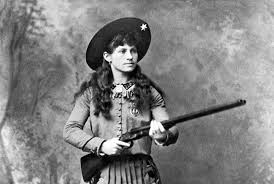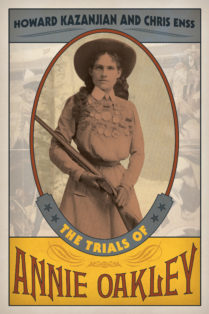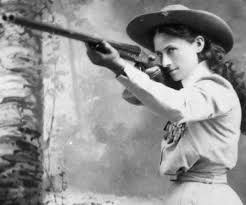Enter now to win a copy of the Will Rogers Medallion Award Winning Book
The Trials of Annie Oakley

On August 8, 1903, a drifter named Charles Curtis made his way to the Harrison Street Police Station in Chicago and filed a complaint to Justice of the Peace John R. Caverly about a woman named Little Cody. Curtis had befriended the woman he supposed was down on her luck and provided her a place to stay for a few days. During her visit with Charles, she stole a pair of pants and generally made herself a nuisance. The complaint charged her with having “made an improper noise, riot, and disturbance.” A warrant for the woman’s arrest was issued, and “Little Cody” was arrested and escorted to jail. The fee she was to pay was $100. She didn’t have the money to give the court and was to be held until she came up with the funds.
The prisoner did not give the clerks or the jail matrons a difficult time. She was chatty during the intake process, but polite. Her appearance was slovenly, clothes were torn and unwashed, and she was obviously under the influence of drugs. She told officials at the facility about her work as a crack rifle shot and of the days, she spent with Buffalo Bill Cody’s Wild West show. The curious matron couldn’t help but pursue the matter further. “You are the noted Annie Oakley, I guess.” The woman proudly announced that she was indeed the famed sure shot.
Charles Curtis came to visit the woman once she was behind bars and seeing her distressed state decided not to press charges.
When arraigned before the justice on Monday morning August 10, the police officer who had booked her into jail stated she was the famous Annie Oakley who had exhibited with Buffalo Bill Cody. The officer informed the court that if she was allowed to go free, she would only spread disease and implored the judge to send her to a women’s asylum where she could be taken care of. The judge agreed and instructed the court to send the woman to Bridewell Prison Farm. Her fine was reduced to $25.
After her day in court, she was taken downstairs to the lock up again. A number of people were waiting for her to arrive so they could talk with her. One of those individuals was George W. Pratt, a reporter for the Chicago American. Pratt had visited Buffalo Bill’s Wild West show many times and was acquainted with several acts associated with the program. He wanted to get the woman’s full story and spent hours with her asking questions about what brought her to such a lowly state. Her answers contained specific information about who performed in Cody’s shows with her, when, and the exhilarating experience she had at the Chicago World’s Fair in 1893. Pratt and other reporters were convinced this woman was the real Annie Oakley. Pratt wrote a story about his first-hand experience with the accused. As many reporters did at that time, he elaborated and sensationalized the account.

To learn more about the famous sure shot read
The Trials of Annie Oakley








